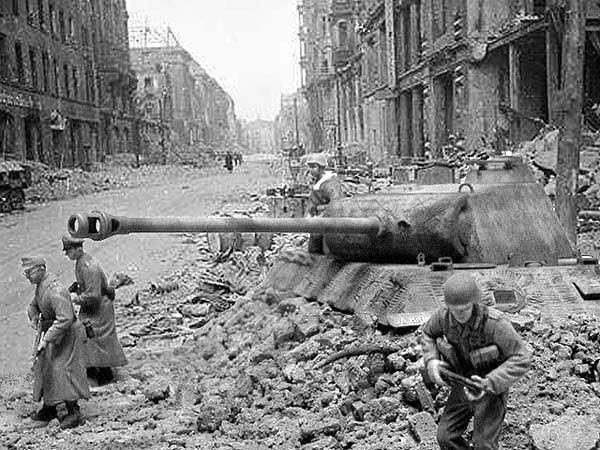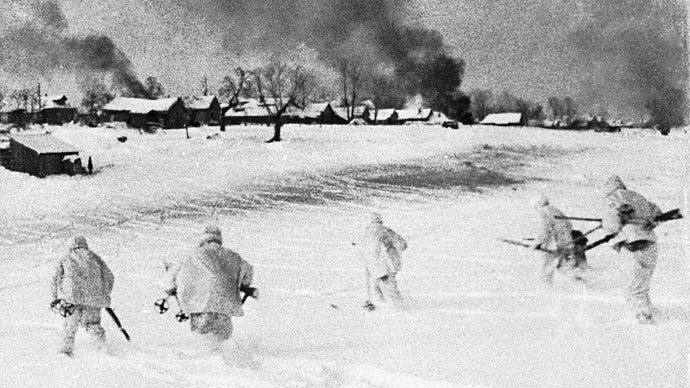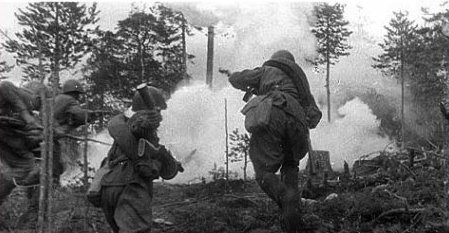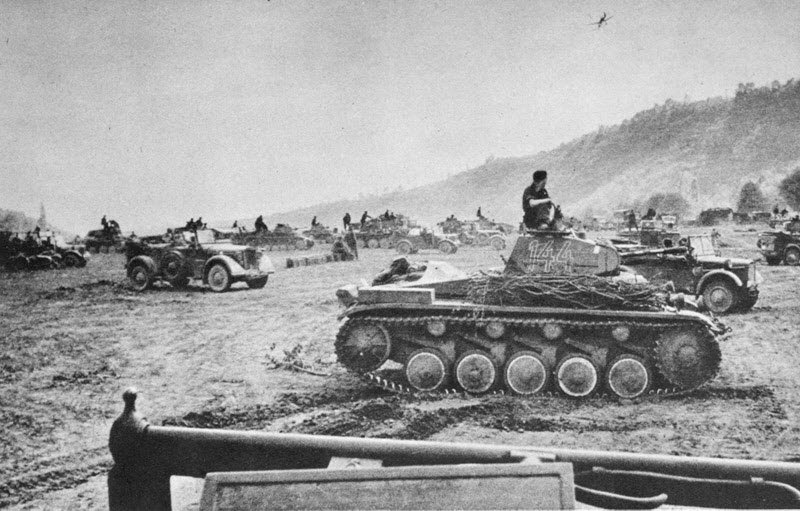The Battle of Kursk was fought during the Second World War from July to August 1943. It was a series of offensives between the German and Soviet forces on the Eastern Front near Kursk, 450 kilometers southwest of Moscow. Operation Citadel was the German codename for the offensive. It led to one of the largest ever armored clashes, the Battle of Prokhorovka, fought on July 12, 1943. The Battle of Kursk was an unsuccessful attempt by the Germans to take over the Soviet forces, and they lost a huge number of men and tanks in the process.
The Soviet line at Kursk was protruding into enemy territory and the Germans attempted to attack from different directions. The Soviet forces held off the offensive and launched counterattacks called Operation Polkovodets Rumyantsev and Operation Kutuzov which helped reclaim the cities of Orel and Kharkov. This was the first time during the war that a German strategic offensive was halted before it could break through enemy lines. The German advance was 8 to 12 kilometers in the north and 35 kilometers in the south.

Also known as the Berlin Strategic Offensive Operation by the Soviet Union, the Battle of Berlin was the final major offensive of the Second World War in Europe. After the Vistula-Oder Offensive of January–February 1945, the Red Army halted on a line 60 kilometers east of Berlin. Operation Clausewitz was the German defense plan against the Soviet attack. After the Soviet offensive was resumed on April 16, the city was attacked from the east and south, and a third force countered the Germans in the north. A Soviet soldier described the enormous amount of equipment deployed during the attack.
The Soviet army was successful in encircling the city and on April 20, 1945, also Hitler’s birthday, the 1st Belorussian Front started shelling the city center, while the 1st Ukrainian Front advanced to the southern suburbs. Hitler and a number of his followers committed suicide before the battle was over. The city surrendered on May 2 while fighting continued to the northwest, west and southwest of the city until May 8, when the war finally ended in Europe. After this battle, the city of Berlin was divided into four as agreed by the Allies.

The Battle of Moscow represents two significant periods of fighting on the Eastern Front during the Second World War from October 1941 to January 1942. By early October, after four million casualties on the Soviet side, the German army had come to within 200 miles of Moscow. This was when Operation Typhoon was launched, an offensive intended to seize the Soviet capital and put an end to the campaign. But the reality turned out to be far from what either side had expected.
The Soviets had a huge but badly organized army. The Germans, on the other hand, with their expertise and equipment could have won any war on the planet. But due to the freezing weather and inability to get supplies through to the Panzer Army, the Soviet defense was able to hold off the Germans. The poor-quality Russian roads had taken out about 40 percent of the German truck fleet and by the time the Germans were within 15 miles (24 kilometers) of Moscow, they were battered and exhausted. The Soviets defended the city by constructing three defensive belts, deploying new armies and bringing troops from the Siberian and Far Eastern Military Districts.

The Second Battle of Kharkov was fought from May 12 to 28, 1942. It was an Axis counter-offensive in the region around Kharkov against the Red Army on the Eastern Front. The objective of the offensive was to eliminate the Izium bridgehead over Seversky Donets or the “Barvenkovo bulge,” an area known for staging Soviet offensives. After the Battle of Moscow, which drove the German forces away from the Soviet capital, the Kharkov Offensive was a new attempt from the Soviet side to expand their strategic initiative.
On May 12, 1942, under the command of Marshal Semyon Timoshenko, the Soviet forces attacked the German 6th Army from a salient established during the winter counterattacks. This offensive further depleted the Red Army’s reserves and failed to gain a significant element of surprise. Initially there were promising signs for the Red Army but the offensives were stopped by German counterattacks. Joseph Stalin and several staff officers made critical errors in underestimating the 6th Army’s potential and overestimating their own forces. This cut off the advancing Soviet troops from the rest of the front. The battle led to almost 300,000 casualties on the Soviet side and 20,000 for the Germans and their allies.
6. Battle of Pearl Harbor, December 7, 1941
The devastating attack on the US naval base at Pearl Harbor in Hawaii by Operation AI of the Japanese Imperial Army, was a complete surprise and took place on December 7, 1941. This attack marked a climax in the worsening relationship between Japan and the Unites States. Once the US fleet was out of their way, the road to conquering all of Southeast Asia and the Indonesian archipelago would open up for the Japanese.
On November 26, a Japanese fleet including six aircraft carriers, two battleships, three cruisers, and eleven destroyers sailed 275 miles north of Hawaii. About 360 planes were launched from this point for the final assault. Four US Navy battleships were sunk and the remaining four were damaged. Additionally three cruisers, three destroyers, an anti-aircraft training ship and one minelayer were also sunk or damaged. A total of 2,403 Americans died in the attack and 1,178 others were wounded. This surprise attack came as a shock to the American people and led to the US entering the Second World War in both Europe and the Pacific. On December 8, the United States declared war on Japan.
5. Battle of France, May to June 1940

The German invasion of France and the Low Countries in 1940 is known as the Battle of France or the Fall of France. In a short space of six weeks starting on May 10, 1940, the German forces defeated the Allies and conquered France, Belgium, Luxembourg, and the Netherlands. Italy also tried to invade France by entering the war on June 10, 1940. The land operations on the Western Front from the German side were all over by June 6, 1944.
The Battle of France saw two main operations on the German side. Fall Gelb (Case Yellow) saw the armored German units break through the Ardennes along the Somme Valley cutting off and surrounding the Allied units advancing to Belgium. After the Belgian and French forces were driven back to the sea, the British evacuated their own troops and several French divisions from Dunkirk in Operation Dynamo. After the British troops left, Fall Rot (Case Red) began on June 5. The remaining French divisions resisted but were soon overcome. Paris was occupied by German forces on June 14. After the battle, France was divided up and occupied by Germany, Italy, and the neutral Vichy government.
4. Battle of Britain, July to October 1940
After the fall of France, Hitler expected the British to seek a peace settlement with Germany, but Britain continued to fight. To bring the war to a quick end Hitler planned an invasion of Britain, codenamed Operation Sealion. For the operation to be successful, the Germans had to first secure the skies over the United Kingdom which were protected by the Royal Air Force (RAF). Germany had been banned from having an air force after the First World War but the Nazi government had reestablished it and it was one of the most formidable air forces in the world. The RAF fought the Germans off with the Hawker Hurricane and the Supermarine Spitfire, two of the best fighter aircraft in the world.
Unable to gain advantage over the RAF, the Germans shifted their focus to London. This would be a critical error by the Germans, because despite the devastation it caused to the residents of London, it also gave the British defenses time to recover. On September 15, the British resisted another massive attack by the Germans who suffered many losses. Later, Hitler postponed Operation Sealion indefinitely. This victory was one of the most important for Britain and proof that air power alone could be used to win a major battle.
3. Battle of Midway, June 1942
The Japanese planned to eliminate the United States’ position as a strategic power in the Pacific by launching the Battle of Midway. At the start of the battle, the Americans were outnumbered about 2 to 1. Between June 4 and 7, 1942, the Battle of Midway began with the US side commanded by Admirals Chester Nimitz, Frank Jack Fletcher, and Raymond A. Spruance and the Imperial Japanese Navy under Admirals Isoroku Yamamoto, Chuichi Nagumo, and Nobutake Kondo. Largely due to developments in codebreaking, the US was able to predict the date and location of the attack, giving them the upper hand.
The Japanese plan was also a failure due to their incorrect assumptions about the American mindset. All of the four large Japanese aircraft carriers which were a part of the force that attacked Pearl Harbor were sunk while the US only lost the carrier Yorktown and a destroyer. Six months after the attack on Pearl Harbor, the Americans had earned a decisive victory over the Japanese and gained an offensive position for the Allies. Military historian John Keegan called the Battle of Midway one of the most stunning and decisive moments in the history of naval warfare.
2. Battle of Normandy, June to August 1944
The Battle of Normandy was codenamed Operation Overlord. With Operation Overload, the Allies launched the largest amphibious invasion of Normandy to free German-occupied Western Europe during the Second World War. Commonly known as D-Day, the operation was launched on June 6, 1944 with the Normandy landings. About 160,000 troops crossed the English Channel on the same day and over two million Allied troops had reached France by the end of August. Special technology was developed to cope with the conditions on the Normandy beaches, including artificial ports known as “Mulberry harbors” and a series of specialized tanks called Hobart’s Funnies.
The Allies carried out a military deception plan called Operation Bodyguard in which electronic and visual misinformation tricked the Germans over the date and location of the main landings. The Allies did not attain their objectives on the first day but gained substantial momentum and captured the port of Cherbourg on June 26 and the city of Caen on July 21. Operation Dragoon was launched to invade southern France followed by the liberation of Paris on August 25. By August 30, 1944, the German forces had retreated across the Seine which marked the end of Operation Overlord.
1. Battle of Stalingrad, July 1942 to February 1943
Considered by many historians as the turning point of the Second World War, the Battle of Stalingrad was fought between July 1942 and February 1943. The German army suffered many losses, after which it began its full retreat and the war turned in favor of the Allies. The Russians consider this battle to be the greatest of the Second World War, and it is also known as the Great Patriotic War in Russia. The battle was devastating with nearly two million military and civilian casualties, one of the greatest losses in military history.
The German 6th Army was not required to fight the battle. Army groups A and B were already on their way to the Caucasus in southwest Russia to secure the oil fields there when Hitler ordered the attack on the city. While it was generally unwise to leave a major city unconquered during an advance, some historians believe that it was mainly Hitler’s personal hatred of the Russian leader Stalin (whose name was part of the city’s identity) which led to the attack. For simple reasons of morale, the Russian army could not afford to lose the city.
Conclusion
Of all the battles fought during World War II, these were the most prominent and had a lasting impact on the final outcome. These offensives and assaults brought about millions of military and civilian casualties as some of the battles directly targeted cities like London, Stalingrad, and Moscow. Led by generals, admirals and commanders with tremendous strength on both sides, each battle’s successes and failures slowly paved the way for the final Allied victory in 1945. "














